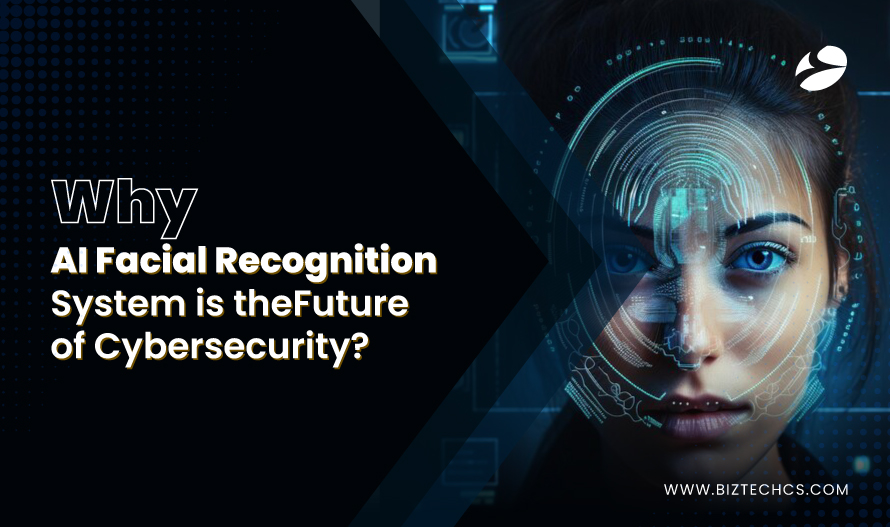Why AI Facial Recognition System is the Future of Cybersecurity?
24 Feb, 2025
10 min read
24 Feb, 2025
10 min read
Table Of Content

Traditional security methods are finding it difficult to keep up with the increasing sophistication of cyber attacks. Facial recognition software driven by artificial intelligence (AI) is becoming a key cybersecurity solution.
The market for facial recognition technology is expected to increase at a compound yearly growth rate of 14% from its 2022 valuation of $5 billion to $19 billion by 2032. This expansion highlights the growing use of security solutions powered by AI.
Additionally, the Department of Homeland Security stated that in operational situations, their facial recognition algorithms achieved over 99% accuracy across a variety of demographic groupings.
By improving threat detection and response capabilities, AI facial recognition technologies are transforming cybersecurity, as we will examine in this blog.
AI facial recognition in cybersecurity is revolutionizing digital defense by including a biometric identification layer. To allow or prohibit access to systems, it maps, scans, and validates facial features.
Faces lower security threats because they are more difficult to forget or steal than passwords. Deepfakes and spoofing efforts are detected by sophisticated AI models, which hinders unwanted access.
Organizations use it for fraud protection, surveillance, and secure logins. AI-driven face recognition keeps improving the speed and accuracy of identification verification as threats change.
Human faces are transformed into data for identification by AI facial recognition technology. It takes a picture and uses algorithms to map face traits. These algorithms examine essential details, including the jawline, nose shape, and eye distance.
After that, the algorithm generates a distinct face signature that resembles a fingerprint. For identification or verification, this signature is compared to data that has been saved in a database. By learning from millions of face samples, machine learning increases accuracy.
More sophisticated systems can recognize changes in lighting, age, and facial emotions. Industries utilize it for banking, security, and customized user experiences.
Businesses use AI facial recognition technology across banking, security, and personalized user experiences. Many partner with an AI development company to develop reliable and high-performing AI solutions to ensure accuracy, security, and seamless integration.
Systems are susceptible to breaches since traditional passwords are frequently weak and simple to crack. AI-powered facial recognition improves security by guaranteeing that only authorized users have access to sensitive information, devices, or physical areas.
Faces are more difficult to disclose or steal than passwords, which lowers the possibility of unwanted access. In addition to improving security, this technology gives consumers a quicker and easier way to authenticate.
Security risks are always changing; therefore, taking preventative action is necessary. AI-powered facial recognition detects known fraudsters, cybercriminals, or unauthorised users trying to access networks.
It instantly notifies security teams of any dangers before harm is done because it operates in real-time. With this quick response capacity, organizations can reduce risks and avoid expensive security events.
Concern over digital fraud is on the rise, particularly in high-risk industries like banking and government. AI facial recognition uses biometrics to verify identities, adding a strong layer of security. Likewise, businesses are tapping into Artificial Intelligence in eCommerce to improve fraud detection and create more personalized shopping experiences. Before allowing consumers access to important sites, AI facial recognition verifies that they are who they say they are.
It stops identity theft, phishing attempts, and account takeovers by precisely confirming identities through biometrics. Businesses can defend internal systems and clients against advanced fraud techniques.
Passwords are frequently reused or stolen in data breaches, making them a weak point in cybersecurity. In MFA systems, AI-powered facial recognition enhances authentication by either supplementing or replacing conventional passwords.
Businesses improve security without creating more hassles, and users enjoy a smooth, password-free experience. This method lessens the possibility of human error and makes it more difficult for hackers to obtain illegal access.
AI facial recognition improves security by making it more difficult to hijack accounts and devices. Faces are more challenging to guess or steal than passwords. Facial recognition combined with multi-factor authentication provides an additional line of defense against online attacks. Limiting access to critical data to authorized individuals lowers the possibility of data breaches.
Modern security systems use AI face recognition to identify dangers instantly. It is used by government facilities, airports, and businesses to identify unlawful people. If a known threat is identified, the system can notify security experts right away. By being proactive, security incidents are avoided before they become more serious.
When it comes to finding missing people, facial recognition is revolutionary. Surveillance film allows law enforcement to scan faces and compare them to databases. This improves the likelihood of recovery and expedites search operations. Even when appearances alter over time, AI guarantees accuracy.
AI facial recognition is used by organizations to expedite identity verification. Travelers, visitors, and employees can check in without waiting in huge lines. This maintains robust security safeguards while increasing efficiency. Quicker authentication enhances user experience and lowers human error.
A clear goal must be established before developing an AI facial recognition system for cybersecurity. The system can be used for identity verification, surveillance monitoring, and access control.
Access control allows Only authorized users to log in or enter secure areas. By instantly recognizing suspicious faces, surveillance monitoring aids in detecting irregularities.
The basis of an accurate facial recognition system is a well-structured dataset. A variety of face samples are available for training from public datasets such as LFW, VGGFace2, and CASIA-WebFace.
Preprocessing, which includes applying data augmentation techniques, aligning faces for consistency, and recognizing faces using MTCNN or Dlib, is essential. These actions enhance the model’s facial recognition capabilities under various lighting, angles, and conditions.
The accuracy and efficiency of the system are determined by the model that is used. Conventional techniques like Dlib and Haar Cascades are straightforward yet imprecise for cybersecurity applications.
Deep learning models such as FaceNet, DeepFace, and ArcFace offer better detection by extracting distinct facial embeddings. Because of its sophisticated loss function and resistance to spoofing, ArcFace is recommended for high-security settings.
Fine-tuning an existing model or creating a new one from scratch is required for facial recognition model training. Transfer learning aids in tailoring a pre-trained model to particular security requirements.
Triplet loss or softmax classification, as well as a deep learning framework such as TensorFlow or PyTorch, are needed for a custom-built model. GPU training ensures great accuracy in real-world applications and speeds up computations.
Immediate threat detection and identification verification are made possible by real-time implementation. OpenCV processes video frames, and Dlib detects facial landmarks for precise alignment.
TensorFlow Lite or ONNX Runtime guarantees optimized AI inference for quicker recognition. The system records videos, extracts face embeddings, and compares them to a safe database to confirm identity.
Robust security protocols guard against unwanted access and identity theft. While saving hashed embeddings improves privacy, encrypting saved face data with AES-256 stops leaks. Techniques for spotting fake faces and attacks include liveness detection and depth analysis.
Multi-factor authentication improves security by combining facial recognition with additional verification techniques like OTPs or biometrics.
The infrastructure and operational requirements of the system determine its deployment. For offline authentication, edge devices such as the Raspberry Pi or Jetson Nano are perfect because they process data locally.
Cloud-based solutions like AWS Rekognition provide scalability, although they necessitate continuous internet access. A hybrid method balances speed and security by processing locally and backing up data in the cloud.
An AI-based facial recognition system needs to be continuously optimized to ensure security. Unauthorized access attempts and questionable activity can be tracked with logging and anomaly detection.
The accuracy of recognition is improved with frequent updates, such as retraining the model with fresh data. Regular security patches guard against vulnerabilities and guarantee the system remains secure against new online dangers.
The transition to AI-powered facial recognition is already taking place; it is no longer a forecast. Companies are incorporating it to detect fraud, stop unwanted access, and expedite identification verification.
AI is a dependable defence because, in contrast to conventional security techniques, it always learns and adapts to new threats.
Our team of skilled AI engineers at BiztechCS can create sophisticated facial recognition systems to improve the security of your company.
Our products are made to detect threats in real-time, guaranteeing a safe and secure online environment. Investing in AI facial recognition now will help you stay ahead of future cybersecurity threats.

Storyblok
29904
By Devik Gondaliya
02 Apr, 2025

Storyblok
30856
By Devik Gondaliya
01 Apr, 2025

Storyblok
31483
By Devik Gondaliya
27 Mar, 2025